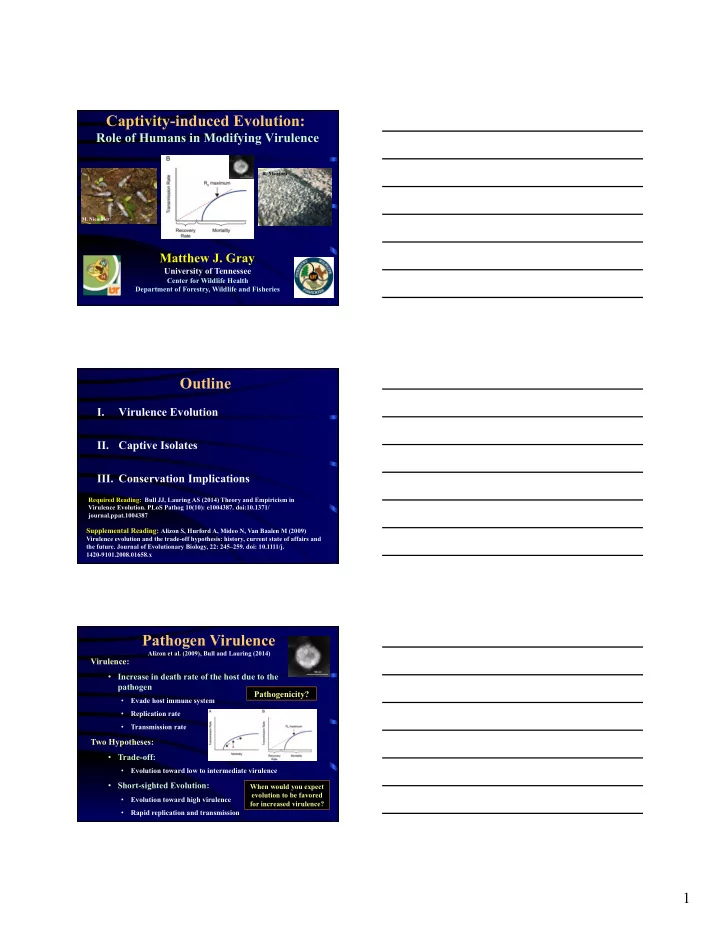

Captivity-induced Evolution: Role of Humans in Modifying Virulence R. Mazzoni M. Niemiller Matthew J. Gray University of Tennessee Center for Wildlife Health Department of Forestry, Wildlife and Fisheries Outline I. Virulence Evolution II. Captive Isolates III. Conservation Implications Required Reading: Bull JJ, Lauring AS (2014) Theory and Empiricism in Virulence Evolution. PLoS Pathog 10(10): e1004387. doi:10.1371/ journal.ppat.1004387 Supplemental Reading: Alizon S, Hurford A, Mideo N, Van Baalen M (2009) Virulence evolution and the trade-off hypothesis: history, current state of affairs and the future. Journal of Evolutionary Biology, 22: 245–259. doi: 10.1111/j. 1420-9101.2008.01658.x Pathogen Virulence Alizon et al. (2009), Bull and Lauring (2014) Virulence: • Increase in death rate of the host due to the pathogen Pathogenicity? • Evade host immune system • Replication rate • Transmission rate Two Hypotheses: • Trade-off: • Evolution toward low to intermediate virulence • Short-sighted Evolution: When would you expect evolution to be favored • Evolution toward high virulence for increased virulence? • Rapid replication and transmission 1
Captive Conditions https://www.youtube.com/watch?v=f2q5jqdsTeA The perfect cauldron for virulence evolution! • Hosts • Strains • Immunocompromised First Evidence Majji et al. (2006) Storfer et al. (2007) Bullfrog Die-off: Alapaha, GA Miller et al. (2007) 2
Trends in Susceptibility Ranaculture isolate 2X more lethal than FV3 Percent mortality Hoverman et al. (2011a): 19 Species Tested Single-species FV3-like Challenges Amphibians 16 Additional Species Brenes (2013): UT Dissertation 100" FV3" 90" RI" 80" SM" 70" InfecCon"(%)" 60" 50" 40" 30" 20" 10" 0" AMGR" AMJE" AMTE" ANBO" ANTE" LIAR" LIBO" LITE" PSFE" PSOR" NOPE" HESC" AMBA" CYPY" SCCO" XELA" Total: RI > FV3 25/35 = 71%; RI>SM for 7 spp Single-species FV3-like Challenges Amphibians 35 Species Brenes (2013) 3
Another FV3-like Isolate from Captivity Waltzek, Gray, and Miller 0% mortality in controls 5% Gray Bull Wood Pallid 85% 80% 95% 80% RI 10% RI 100% RI Pallid vs. GA Bullfrog Isolate Waltzek, Gray, and Miller 0% mortality in controls 45% 35% 5% Pallid Isolate Caused Mortality; Bullfrog Isolate Resulted in Infection Multiple Captive Isolates Geng, Gray, Waltzek, Une, and Miller Lithobates Lithobates clamitans catesbeianus (green frog) (American bullfrog) Six Isolates: Captive = GA bullfrog, MO pallid Wild = TN, MN, and ME Pseudo-wild = Japan (Am. Bullfrog) 4
M i ssouri I nfected Survi ved+N Survi ved+I nfected i e+I nfected D ai ne I nfected i nnesota M Tennessee Japan M i e+N eorgi a G ai ne M i nnesota M Tennessee Japan i ssouri M eorgi a G D I nfected i vi d M eorgi a M i ssouri Japan Tennessee M i nnesota M ai ne G eorgi a i ssouri i e+N Japan Tennessee M i nnesota M ai ne D i e+I nfected Survi ved+I nfected Survi ved+N I nfected D ual s G I nd 1 7 1 6 1 5 1 4 1 3 2 1 1 8 0 1 9 8 7 6 5 4 3 2 1 1 1 1 2 b um N ays D 1 9 0 2 Survival Curves Green Frogs 20 18 JP 16 14 MO 12 of 10 ers 8 GA 6 4 2 Significant Necrosis in Liver 0 Final Mortality & Infection Green Frog 100% % Indiviuals Infected 80% 60% 40% 20% 0% Isolates ot ot Survival & Infection American Bullfrog 20 18 16 Numbers of Individuals 14 GA 12 100% 10 % Indiviuals Infected 80% 8 60% Only GA 6 40% Captive Isolate 20% 4 0% 2 Isolates 0 ot ot 1 2 3 4 5 6 7 8 9 10 11 12 13 14 15 16 17 18 19 20 21 Days 5
Risk of Pathogen Pollution Majji et al. (2006), Storfer et al. (2007), Mazzoni et al. (2009), Hoverman et al. (2011a), Brenes (2013) Mazzoni Conservation Implications Kristine Smith, DVM From 2000-2006, the U.S. imported >1.5 billion individual animals (fish & wildlife; Smith et al. 2009) 90% fish, 2% amphibians, 1% reptiles 25 million live amphibians imported to U.S./year Ranavirus Positive • Hong Kong = 89% • Dominican Republic = 70% • Madagascar = 57% Smith et al. (unpubl. data) Questions?? Photo: N. Wheelwright mgray11@utk.edu +1-865-974-2740 6
Recommend
More recommend